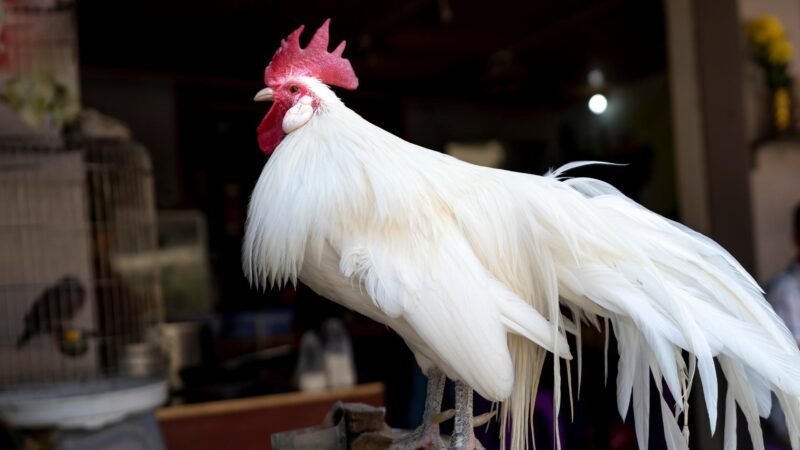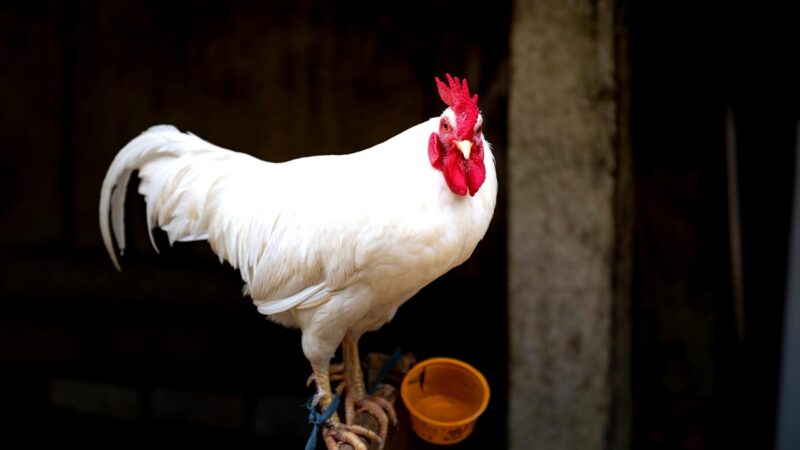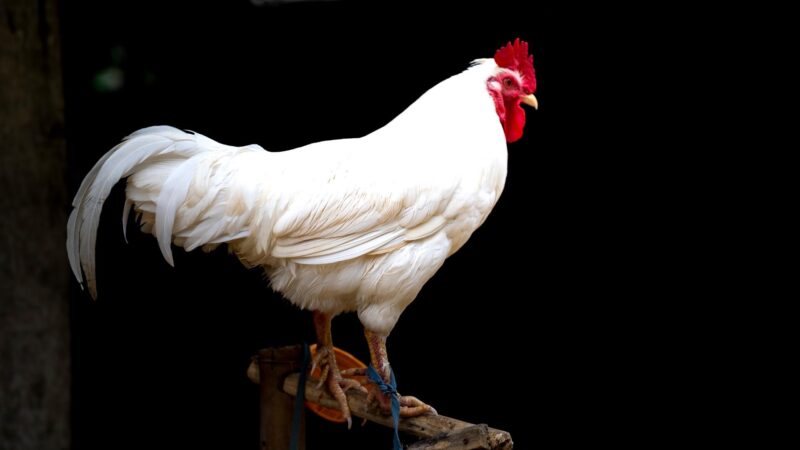The Yokohama chicken is quite an elegant chicken breed. With its snow-white plumage and flowing tail feathers being dragged as it walks, there’s no denying that this bird breed certainly draws attention.
But what exactly is a Yokohama chicken? Despite its Japanese-sounding name, the Yokohama chicken is a German breed notable for its fancy appearance.
It is characterized by beautiful white plumage and extremely long tail feathers that often touch the ground. It is mostly bred for its exhibition or show quality appearance.
But where exactly did these chickens get their long tails from? Is the Yokohama chicken a rare breed? These are just some of the questions that this article seeks to answer. So if you want to know more about such an elegant breed, just continue reading.
Yokohama Chicken Identification

What Do Yokohama Chickens Look Like?
The Yokohama chicken is a beautiful breed that’s often bred for chicken or poultry shows. They have distinct physical characteristics that make them rise above the others – particularly their elegantly long tail and saddle feathers. In some varieties, these feathers can reach up to 4 feet long.
This small chicken breed has long, plump bodies, a long neck, and a pair of long legs. Its legs, feet, and beak are yellow, and its combs and wattles are red.
It also has reddish or orange-red eyes. Unlike most chicken breeds, the Yokohama chicken has small combs – usually as small as a pea or a walnut. Similarly, it has small wattles, with some not even having any visible wattle at all.
There are two varieties of the Yokohama chicken recognized by the American Poultry Association Standard of Perfection: the White and the Red Shouldered. As its name implies, the White Yokohama chicken has pure white plumage that gives it a pristinely elegant appearance.
On the other hand, the Red Shouldered Yokohama chicken has white plumage over the majority of its body except for its shoulders, back, and breast, which are covered in red feathers with white flecks.
How Long Does a Yokohama Chicken Live?
The average life expectancy of the Yokohama chicken ranges between six to eight years. This is shorter than the average lifespan of chickens, which is up to 10 years. This is even considering the fact that their ancestors have been cross-bred with other chicken breeds to improve their hardiness.
How Big Do Yokohama Chickens Grow?
As earlier established, the Yokohama chicken is a small chicken breed. While their exact height is still unknown, an adult Yokohama chicken can grow to weigh around 4.5 pounds. But given their small size, their tail feathers can grow up to 4 feet long, which is quite impressive.
Are Yokohama Chickens a Heavy Breed?
Yokohama chickens are not a heavy breed. On average, a Yokohama rooster can weigh around 4.5 pounds, while a hen can weigh around 3.5 pounds.
Yokohama Chicken Wingspan
The exact wingspan of the Yokohama chicken is unknown. However, it has been observed that this small chicken breed is capable of flight. This may be due to its long feathers and lightweight body.
What Is Yokohama Chicken Known For?
The Yokohama chicken is best known for exhibitions or pet shows. While pet shows are popular for exhibiting pets like dogs and cats, the Yokohama chicken is among the bird species often presented in these contests. This goes to show how fancy this breed truly is.
With that said, Yokohama chickens are also popular as pets. They are generally docile and friendly, making them great for families. They are also surprisingly quiet for a chicken, which makes them the ideal pet if you’re living with neighbors close by.
The Yokohama chicken is not considered an egg-laying breed since it only produces around 80 to 100 eggs in a year. But in most cases, hens start to get broody once they lay around 12 eggs, and that’s the most they produce within their laying cycle.
They are likewise not considered a meat breed because they are small-sized, so their carcasses do not produce enough meat.
Where Do Yokohama Chickens Originate?
The Yokohama chicken is a German breed in the sense that the breed as it is seen today has been developed in Germany. However, its ancestors are the Minohiki breed of chickens that originated in Japan.
These long-tailed Japanese chickens used to have tails as long as 27 feet. The first recorded export of the Minohiki was in 1864 when the breed was brought to Paris from the Port of Yokohama. The fancy bird was eventually named after the port it originated from.
A few years after its arrival in Paris, some of these birds were brought to Germany. However, not all of the birds survived the Journey. To make these birds more hardy, one Hugo du Roi was recorded to have bred these long-tailed birds with local chickens. As a result, the Yokohama breed with shorter tails was developed.
How the Yokohama chicken arrived in the United States remains unclear. However, the American Poultry Association Standard of Perfection recognized the White and Red Shouldered Yokohama chicken breeds in 1981.
Because they are more of an ornamental breed than a livestock breed, the Yokohama chicken’s popularity began to decline over the years. Currently, The Livestock Conservancy still lists the breed under Critical Status.
What Are the Distinct Characteristics of a Yokohama Chicken?
The most distinct characteristic of the Yokohama chicken – whether it’s the white or the red-shouldered variety – is its long tail and saddle feathers. These feathers can grow up to four feet long and are often dragged by these chickens on the ground. And that’s not something you see among other chicken breeds.
For the red-shouldered variety, a distinct characteristic is its unique coloration. As its name implies, it has a plumage of red feathers with white flecks around the shoulder, back, and breast areas. This is easy to spot, especially considering its pristine white plumage.
Overall, there’s no denying that the Yokohama chicken is a stunning breed. Whether it’s the pure white or red-shouldered variety, its elegance is truly unmatched.
Yokohama Chicken Habitat
It is believed that the ancestors of the Yokohama chicken lived in the rainforests of Asia. But even then, they are resistant to cold temperatures and can even freely roam around during the winter season. At night, these birds prefer to sleep on trees to keep themselves safe from predators.
Today, Yokohama chickens are often found in large farms with enclosed coops. This chicken breed loves having the freedom to walk around large spaces, so it’s essential that the farm they will be housed in is big enough for them. It also helps that the coop has perches where they can sleep above the ground.
What Do Yokohama Chickens Eat?

Like most chickens, the Yokohama chicken is also an omnivore. They often forage the farm for grains and cereals, but they also prey on small insects and worms when they come across them. If there’s not enough food to forage, the Yokohama chicken also loves pecking on fruits, vegetables, and chicken pellets.
Due to the Critical status of this breed, they must be given the right amount of nutrients to ensure good health. This is especially true for the hens since calcium deficiency during their laying cycle produces weak-shelled eggs.
Yokohama Chicken Temperament
Yokohama chickens are known for being docile and friendly. These ornamental birds love foraging and are surprisingly quiet for chickens, which makes them the ideal pet for families with children and pets. They rarely show aggression, and it is only usually the roosters who exhibit that characteristic. It is exactly because of this docile temperament that the Yokohama chicken makes great show pets.
Are Yokohama Chickens Aggressive?

Yokohama chicken is not generally aggressive. In fact, they are the exact opposite of an aggressive chicken since they are calm and docile. However, the Yokohama rooster can be quite territorial, which leads them to show aggressive behaviors when they feel like their territories have been compromised. But even then, they are not as aggressive as other roosters.
How Much Is a Yokohama Chicken Worth?
Despite being a fancy breed, the Yokohama chicken is surprisingly affordable. The price of an adult Yokohama chicken ranges between $3 to $8, depending on its gender, variety, and weight.
On average, males are more affordable, and a 4.5-pound adult can be bought at around $4 to $5. In contrast, adult females weighing around 3.5 pounds are sold for between $6 to $9. On the other hand, day-old not-sexed chicks are available from $3 for the red-shouldered variety and $5 for the white variety.
How Many Eggs Do Yokohama Chickens Lay?
Yokohama chickens are not good egg layers. At most, a single Yokohama hen can only lay around 80 eggs during its laying cycle if the hen doesn’t get too broody. If it does, then expect it to lay only around 20 eggs or less.
What Color Eggs Do Yokohama Chickens Lay?
Yokohama chickens lay cream-colored eggs. These eggs are also quite small, often only weighing around 40 grams.
Without a doubt, the Yokohama chicken is a stunning chicken breed. Whether it’s the White or the Red Shouldered variety, it possesses an elegance that cannot be outshined. That makes it easy to see why it’s primarily bred for show. Hopefully, more conservation efforts would be put into action to protect this beautiful breed.
List of Sources
Breeds of Livestock – Yokohama
